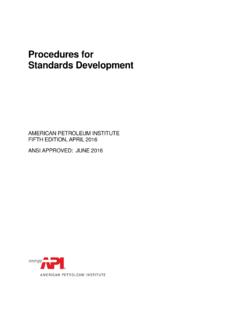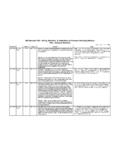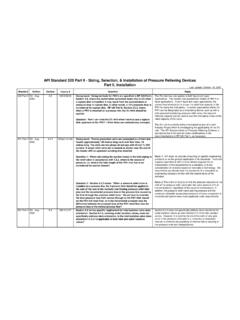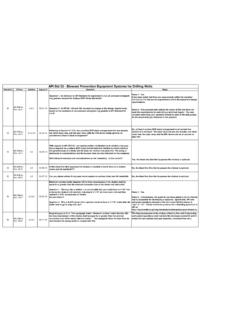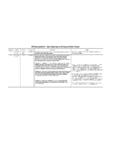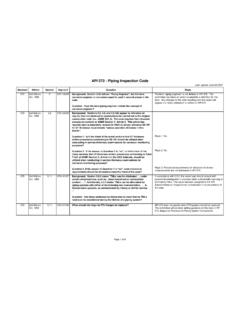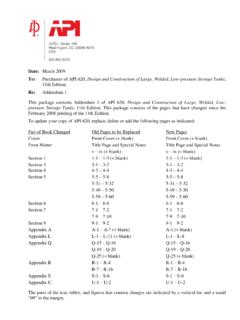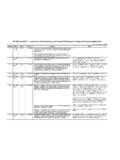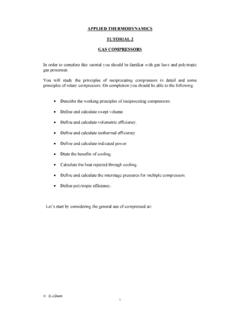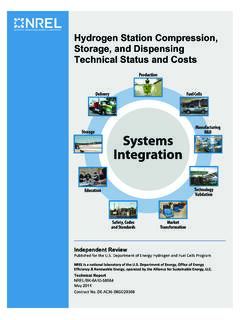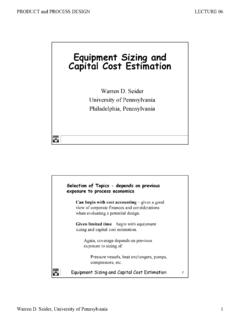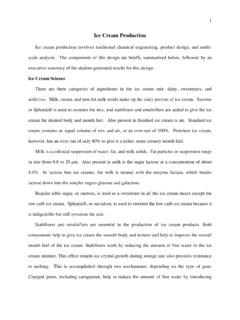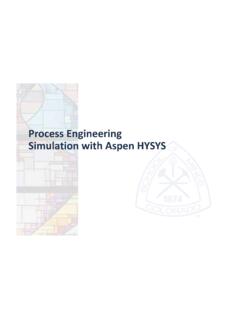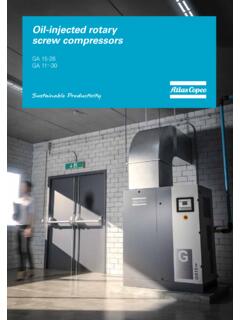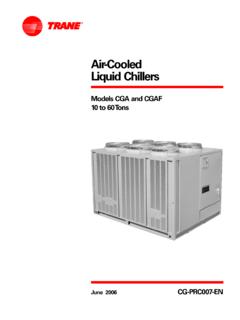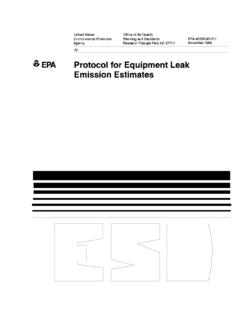Transcription of API Standard 618 - Reciprocating Compressors for Petroleum ...
1 Last Update: June 8, 2011 StandardEditionSectionInquiry #QuestionReply6184th Ed. - June 1995 General 618-I-01/08 Is ASTM A 395 to apply to non pressure containing NI castings? Yes6184th Ed. - June API 610, 617, 611 and 612, there are some sections about the allowable forces and moments acting at the nozzles of the pump, turbines, and Compressors . Normally, these are based on the specifications of NEMA SM23 with adding some factor, but in API 618, we didn't find any words about that. So, please tell me which Standard will be adapted and where we can get it. Our LPEC is a petrochemical engineering corporation and imported some Reciprocating Compressors ACC to API 618 we can't find any Compressors differ from the machines you reference in that they are isolated from their piping by pulsation bottles or vessels. These latter vessels, through their mass and support system, absorb much of the loads from the piping. You are correct, there are no nozzle load limits specified in API 618; however, makes it the joint responsibility of the user and vendor for the machine to perform satisfactorily.
2 Section defines the coordinate system for applied nozzle loads and requires the manufacturer to furnish allowable loads. It is recommended the user consult the manufacturer for guidance. 6184th Ed. - June : As we all know horizontal Reciprocating Compressors are fitted with rider rings on the piston, which are likely to be worn out with continuous operation. Hence compressor manufacturers recommend a yearly maintenance to replace these parts. Since calls for "an expected uninterrupted operation of at least 3 years", my question to you is, that whether such 3 years continuous operation is really possible or not, OR, this clause neglects the downtime required for the annual : Does API 618 insist, that the compressor be designed for three years of maintenance free operation?Yes, it is the intent of this Standard to provide equipment (including auxiliaries) that has been designed to provide 3 years of uninterrupted operation, without annual maintenance.
3 It is realized that there are some services where that objective is easily attainable and others where it is more difficult. The system design is a very important criterion in meeting this objective. Note that this is a design requirement. Manufacturers may choose to recommend reduced maintenance intervals dependant upon the proposed operating Standard 618 - Reciprocating Compressors for Petroleum , Chemical, and Gas Industry ServicesLast Update: June 8, 2011 StandardEditionSectionInquiry #QuestionReplyAPI Standard 618 - Reciprocating Compressors for Petroleum , Chemical, and Gas Industry Services6184th Ed. - June : We have experienced some failures in compressor crossheads due to inadequate lubrication, and some manufacturers perceive that API requirements for load reversals are only minimum requirements, and hence meeting them would not guarantee that lubrication is adequate. Their standpoint is that API 618 does not state that the compressor has to be designed to run at this minimum requirement, simply that the criteria should be met.
4 The same requirement existed on the 3rd edition of API 618, and my understanding is that it will be kept unchanged on the forthcoming 5th requires that the duration of the load reversal at the crosshead pin shall not be less than 15 degrees of crank angle, and that the magnitude of the peak combined reversed load shall be at least 3% of the actual combined load in the opposite direction. Question: Is it the intent of API 618 that this amount of load reversal be enough to ensure correct lubrication of the crosshead assembly?Question 2: If the manufacturer's design requires a larger load reversal to ensure proper lubrication, should this be considered a deviation to 1: The API 618 Task Force is unable to respond to this question at this time. This information is currently under consideration by the task force and will appear in the next edition once specific guidance has been 2: See Reply Ed. - June Section : Does this Section require that a detailed lateral study of the compressor crankshaft be carried out, or is it sufficient that the study only include the drive system?
5 This Section was intended to have a primary focus on the drive train of the compressor , since, in most cases, the lateral stiffness of the crankshaft is very high and the lateral frequencies are typically well above the operating speed range. Consequently, a detailed lateral study of the crankshaft would not normally be necessary, or expected. The report of such a study would not normally be necessary, or expected. The report of such a study should contain a statement indicating that a detailed lateral study of the crankshaft was not performed and the reasons. Any studies performed by the manufacturer or similar equipment should be cited as a means of substantiating the statement. If a lateral critical speed was expected to be below, within, or close to, the operating speed range, then a detailed laterals study of the crankshaft would be necessary. Last Update: June 8, 2011 StandardEditionSectionInquiry #QuestionReplyAPI Standard 618 - Reciprocating Compressors for Petroleum , Chemical, and Gas Industry Services6184th Ed.
6 - June to of API Standard 618, "except for the belt driven units, the vendor shall provide a torsional analysis of the complete drive train. Torsional natural frequencies of the driver- compressor system (including couplings and any gear unit) shall be avoided within 10 percent of any operating shaft speed and within 5 percent of any other multiple of operating shaft speed in the rotating system up to and including the tenth multiple. For motor-driven Compressors , torsional natural frequencies shall be separated from the first and second multiples of the electrical power frequency by the same separation margins." Is the required distance in % a + or - (Amplitude) or Peak to Peak declaration?We do not understand the reference to amplitude or Peak to Peak. Torsional natural frequencies shall be avoided: in the range of 90% (100 - 10) of any operating shaft speed; and, in the range of 955 (100 - 5) of a multiple of operating shaft speed to 105% (100 + 5) of that multiple operating shaft speed.
7 Please refer to API 684 for a detailed discussion on torsional analysis. 6184th Ed. - June Section : Does this Section require that a detailed lateral study of the compressor crankshaft be carried out, or is it sufficient that the separate study only include the quill shaft system?This Section only requires an analysis of the low-speed quill shafting and coupling. 6184th Ed. - June to Section , when specified, the running bore of the cylinder shall be coated with tetrafluoroethylene (TFE). The method of application shall be agreed on by the user and the vendor. Please provide some references for process gas Compressors using such coating, and the benefits and features of this are two known methods of applying such a coating. One is to spray the liner with an aerosol containing tetrafluoroethylene, and the other is to burnish the liner with solid tetrafluoroethylene. Some purchasers believe that this coating shortens the break-in period of a non-lubricated compressor cylinder and reduces that initial wear on the piston rings and rider bands.
8 It is for this reason that the process is a "when specified" requirement, with the method to be agreed upon by the user and the vendor. 6184th Ed. - June the thermostatic valve bodies in the cooling circuit required to be cast steel or is cast iron acceptable?The oil temperature control valve in the lubricating oil cooling system, as illustrated in Figure G-5 is required by Section to be steel. The temperature control valve in the jacket water cooling system, as illustrated in Figure G-1, Plan D, is required by Section to be steel. 6184th Ed. - June 1: Section states: The rated pressure for the frame lubrication system shall be a gauge pressure of 10 bar (150 psi) minimum. Please clarify whether 10 bar is the recommended design pressure or the normal operating 2: What is the significance of specifying 10 bar when the normal operating pressure in lube oil systems of various compressor manufacturers is a maximum of 5 bar?Question 3: Does the bullet ( ) in apply only to the purchaser specifying the type of driver for the lube oil system?
9 Reply 1: This requirement refers to the minimum design 2: See Reply 3: Update: June 8, 2011 StandardEditionSectionInquiry #QuestionReplyAPI Standard 618 - Reciprocating Compressors for Petroleum , Chemical, and Gas Industry Services6184th Ed. - June to Section of API Standard 618, are the bonnets of heat exchangers in the cooling circuit required to be cast steel or is cast iron acceptable?For the heat exchangers in the lubricating oil cooling system, requires the oil-pressure containing components to be steel. There are no specific materials requirements in API Standard 618 for the water pressure containing components. Where the purchaser does not specify specific materials requirements on the data sheet, then, in accordance with , the manufacturer's Standard materials of construction are acceptable. 6184th Ed. - June production tests on castings as described in through applicable to all casting pieces for Reciprocating Compressors , or only for pressure-containing castings?
10 Yes, Sections through pertain to testing for all Ed. - June to Section of API Standard 618, which of the following applies: (1) The specified motor reserve of 10 percent applies to the design phase and when measured during actual operation the reserve measured may be less than 10 percent in accordance with the tolerances for power (3 percent maximum, as per point of API 618) and the measuring instruments (as per Acceptance and Performance test)., or (2) The motor reserve of 10 percent has to be available in the full amount at any Section allows for the selection of a driver of the appropriate rating during the design phase. The 110 percent applies at the design phase. Please also refer to the last Section of Appendix B. 6184th Ed. - June says, For induction-motor- compressor installations, motor current variations shall not exceed 40 percent of the full load current". Assuming, for instance, that the full load current of the motor is 100, should the current variations be between 60A and 140A or between 80A and 120A?
